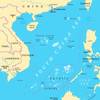Stena Discovery Performance Improved With Enhanced Steering System
On February 14, the world's largest high-speed ferry catamaran Stena Discovery took off from Belfast, after a planned drydocking, and about one hour out at sea on the captain's command the waterjet control was switched over to steering by a retrofitted Humphree Interceptor Steering System. While the interceptors engaged and provided the means for directional control of the vessel, the steering buckets of the four Kamewa 160 SII waterjets, in total absorbing a power of 68.5 MW, automatically returned to their neutral, or boost position, allowing all waterjet thrust to be vectored forward for maximum thrust, and eliminating the waterjet bucket drag.
During transit to Hook van Holland in the Netherlands, a series of trials confirmed supreme performance of the Humphree interceptor steering system. The turning response of the vessel with the steering interceptor system active was described as faster and the general turning behavior compared well with that of four waterjets steering up to the bucket steering angle equivalent to full interceptor stroke. When passing the Land's End of England with quartering following sea and a significant wave height of about 10 ft. (3 m), the Captain concluded that the interceptor steering system indeed worked fine and that the vessel was notably faster. In moderate sea at a vessel speed of 40 knots, the reduction of speed when steering with the interceptors was significantly reduced. The gain was recorded to one knot, or three MW in terms of delivered power. As the improvement is increasing with increasing sea state — the annual fuel saving is expected to be quite substantial. In addition, the auxiliary power requirement was reduced from about 120 kW to 4 kW, which adds up to an additional yearly fuel saving as well as it gives an idea of the mechanical and structural advantages of using Humphree interceptor units as control devices, whether they are used for steering or active damping of ship motions.
The patented Humphree interceptor steering system has been developed and delivered by the marine division of LA.ME., which is an Italian-Swedish joint-venture with electro/mechanical engineering and production in Milan and sales and hydrodynamic expertise in Gothenburg. The steering system comprises of four (two on each transom) compact hydraulically operated HV160 vertically mounted Humphree interceptor units, two hydraulic power packs, one in each hull, and a main control system unit for manual operation and ship system integration. The steering interceptor system is fully integrated into the main steering system, including the autopilot, waterjet control system, and the ship's integrated monitoring system. When the interceptor steering system is active, the steering command operates only the interceptors to their maximum stroke, while if further steering is needed the waterjets are requested to engage and be deflected to add steering force.
In rough seas, or should an emergency situation occur, the captain will have the joined force of full interceptor steering and full waterjet steering, resulting in significant fuel savings and/or improved safety at sea. Humphree Interceptor Steering Systems are designed to offer owners of high-speed vessels a unique means to increase maintained vessel speed and/or lowering fuel bills and reducing the environmental impact on sensitive routes.
First Order For Dolphin Propulsion System
Seven Seas Voyager, the new 50,000-gt cruise ship under construction by T. Mariotti at its Genoa yard for delivery to Radisson Seven Seas in 2003, will be among the first ships to be equipped with the new Dolphin podded propulsion system, a system which was jointly developed by STN ATLAS Marine Electronics and John Crane-Lips.
Podded propulsors of the system are designed to deliver 2x 7,000 kW at 170 rpm. Main features include integration of a powerful electric drive into a hydro-dynamically optimized pod below ship, resulting in a directly-driven propeller. Extensive CFD analyses and model tank tests have led to the development of a pod shape with enhanced efficiency and maneuvering characteristics. Dolphin has been developed for power ranges extending from 3 MW to more than 19 MW and is suitable for a wide variety of vessels designed for high speed and good maneuverability operation. With a continuous rotation angle of 360 degrees in the vertical axis, the pod ensure optimum maneuverability for commercial vessels as well as those engaged in offshore dynamic positioning.
The standard drive of the fixed-pitch propeller includes an air-cooled six-phase synchronous motor; gears, shaft systems, rudders and stern thrusters forming part of conventional electric drives are not required. The system's shaft is protected within its casing by a combination of face and lip seals.
In addition to the Dolphin system, the scope of delivery by STN ATLAS Marine Electronics and John Crane-Lips for Seven Seas Voyager includes a complete propulsion system with synchro-converters, control and joystick system, diesel alternators, and a high-voltage distribution assembly with propulsion and main transformers as well as bow thrusters.
Austal Pioneers New Approach To Jet Room Design
Austal Ships recently released details of its Microplate Technology, an innovation developed through the company's commitment to vibration control, environmental diligence and the longevity of high-speed vessels. The result: a radical new approach to the design of jet room structures. "As water jets can cause considerable and potentially damaging vibrations, it is important that a sound knowledge of vibration control with respect to fatigue is employed in the design stage," said Chris Norman, Austal's director. "Austal's Design and Advanced Engineering Departments have developed a sophisticated in-house program dedicated to passive vibration control though design optimization."Austal is able to evaluate the natural frequency of plate panels and plate stiffener combinations, taking into account the panels’ edge constraints and other variable such as water on one side of the plate panel. Various panels are then turned to ensure their harmonics are out of phase with the natural operating frequencies generated.
In addition to this vibrational design approach, the global waterjet structure is designed to satisfactorily transmit the waterjet thrust and steering loads into the surrounding structure. The design group then creates detailed finite element analysis structural models and the results are assessed to ensure that the fatigue life of the structure is optimized. Particular attention is paid to structural detail in order to avoid discontinuities and other stress raising features.
Increased Power For The Sulzer RTA96C
Wärtsilä Corporation has increased the power outputs available from Sulzer RTA96C low-speed marine diesel engines by approximately four percent, and also added a 14-cylinder model to bring the maximum output available up to 80,080 kW (108,920 bhp).
The higher powers and the 14-cylinder engine are intended to meet the requirements of shipowners and shipbuilders for both large, fast post-Panamax containerships and the next generation of larger ships of up to 10,000 TEU. The RTA96C now gives 5,720 kW (7,780 bhp) per cylinder maximum continuous output at 102 rpm. Thus the power output of the 12-cylinder RTA96C is increased from 65,880 kW (89,640 bhp) maximum continuous output to 68,640 kW (93,360 bhp).
The RTA96C is the most powerful in the Sulzer RTA series of low-speed marine diesel engines. The new RTA96C engines have the same dimensions and masses as the existing RTA96C engines built to the latest design standard.
They also have exactly the same brake specific fuel consumption (BSFC) and cylinder lubricating oil feed rate. Their times between overhauls are expected to be three years for major components. The NOx emissions of the RTA96C are within the limits set by the IMO regulation in Annex VI of the MARPOL 73/78 Convention.
Four Sulzer 12RTA96C low-speed diesel engines have been ordered by Odense Steel Shipyard A/S in Lindø, Denmark, for installation in four large post-Panamax container ships building there for A.P. Møller. The four ships are of A.P. Møller's S-/C-class, each having a container capacity of 6,600 TEU. The 12-cylinder engines will each develop 65,880 kW (89,640 bhp) at 100 rpm. The engines will be built under license from Wärtsilä Corporation by HSD Engine Co. Ltd. in Korea. The 12-cylinder RTA96C engine is the most powerful in the Sulzer RTA series of low-speed marine diesel engines.
Voith Adds To Its Innovative Range
Voith Schiffstechnik has introduced a pair of new technologies to its already innovative range of Voith Schneider propulsion products. The Voith Turbo Fin is a rotating cylinder at the leading edge of the stabilizing fin which influences the flow acting on a tug's hull. According to Voith, the VTF smoothes the flow to reduce turbulence and increases lift which, in the indirect towing method, results in higher transverse forces. After exhaustive model tests, Voith claims that a tractor tug fitted with a VTF unit was proven to provide an 18 percent increase in the transverse force compared to a tug without the new fin. Making the option more attractive; the manufacturer says that the VTF is available for a small cost for both refit and newbuild applications.
The other significant new development from Voith is the Cycloidal Rudder (VCR) (pictured below). The VCR, based on the proven Voith Schneider Propeller, is a propulsion and maneuvering system for newbuild ships that require maximum maneuverability over the entire speed range. The VCR has a rotor casing with a vertical axis of rotation, but with two ruder blades projecting from it. The configuration enables two modes of operation, passive and active. The passive mode is used for cruising/high speed maneuvering, and in this mode only the rotor casing performs partial rotations in both directions, thus the locked rudder blades are adjusted relative to the flow and act like conventional rudders. For slow speed maneuvering the VCR uses the active mode. The uniform rotation of the rotor casing is superimposed by an oscillating movement of both blades around their own axis. In essence, this mode allows for an identical thrust to be generated in all directions.
MAN B&W Targets Mid-Size Containership Niche
While much of the innovation in the containershipping segment has been focused on ever-larger ships, MAN B&W has made a point of ensuring that its engine ranges best suited for the medium-size containershipping segment — up to 3,000 teu — maintains its technological edge to ensure ship owners get the power, economy and efficiency they demand. While the larger containershipping segment has garnered a well-deserved portion of attention given the technological challenges, the engine maker notes in its new publication "Propulsion of Medium Sized Containerships" that the market for new containership construction is expected to grow seven to eight percent per annum, at least for the next five to 10 years. While the market for ultra large containerships will undoubtedly grow, so too will the demand for smaller, feeder carriers, as the number of ports able to handle the largest ships will still be limited.
Another factor boding well for the segment is the age of the fleet, with many ships approaching 35 to 40 years old and heading for scrapping. Some analysts estimate a need for between 100 to 120 ships per year in the 1,000 to 3,000 teu range. To fulfill the tremendous power need, MAN B&W offers its MC engine program covering the power span from 1,600 to more than 68,500 kW. The latest additions to the range include the L60MC-C and the L70MC-C specifically targeting the RoRo and the medium-sized container vessel market.
Featured videos

Inside the Electrified Truckable Tug

Inmarsat Enhances Service to Drive Digitalization

Tracking Foreign Vessels Working in the U.S. Jones Act Market
Subscribe for
Maritime Reporter E-News
Maritime Reporter E-News is the maritime industry's largest circulation and most authoritative ENews Service, delivered to your Email five times per week









